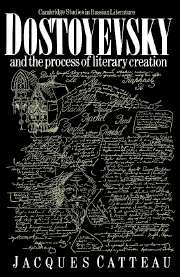Book contents
- Frontmatter
- Contents
- Preface to the English edition
- List of abbreviations
- General editor's note on transliteration and references
- General introduction
- PART I The creative environment
- PART II The process of creation
- Introduction
- 7 The writer at work
- 8 The great dialogue: the news item
- 9 The great dialogue: migrant images
- 10 The play of dialogue
- 11 The unity of thought in the novel
- 12 The summit of creative interrogation: ‘The Life of a Great Sinner’
- 13 A Raw Youth: reasons for choice
- 14 A Raw Youth: the appearance of the vision
- 15 A Raw Youth: the human architecture
- 16 A Raw Youth: the Idea of the novel
- 17 The composition of the novel in Dostoyevsky's work: choice of chronicle form
- 18 Composition of the novel in A Raw Youth: chronicle and stories
- Part III Time and space in the world of the novels
- Conclusion
- Notes
- Select bibliography
- Index of names
Introduction
Published online by Cambridge University Press: 18 December 2009
- Frontmatter
- Contents
- Preface to the English edition
- List of abbreviations
- General editor's note on transliteration and references
- General introduction
- PART I The creative environment
- PART II The process of creation
- Introduction
- 7 The writer at work
- 8 The great dialogue: the news item
- 9 The great dialogue: migrant images
- 10 The play of dialogue
- 11 The unity of thought in the novel
- 12 The summit of creative interrogation: ‘The Life of a Great Sinner’
- 13 A Raw Youth: reasons for choice
- 14 A Raw Youth: the appearance of the vision
- 15 A Raw Youth: the human architecture
- 16 A Raw Youth: the Idea of the novel
- 17 The composition of the novel in Dostoyevsky's work: choice of chronicle form
- 18 Composition of the novel in A Raw Youth: chronicle and stories
- Part III Time and space in the world of the novels
- Conclusion
- Notes
- Select bibliography
- Index of names
Summary
Before we break into the study of the writer, or cross the threshold of his laboratory, or rummage among the artist's rough sketches, we must ask ourselves if this intrusion is right or profitable.
Any creative artist, especially a novelist, is by nature a public person and Dostoyevsky, who wrote for ‘all the Russian reading public’, was well aware of this. A literary vocation may be described as a will to gain power over people's minds, just as politics is a struggle for power in the city. Although literature was not a publicity stunt for Dostoyevsky, who uses the word ‘I’ very little in his works, he knew that he was placing himself, like a prophet, in full view of the crowd and of posterity.
But apart from the confidences which he authorised about his way of working, would he have allowed anyone to enter the inviolable and mysterious realm of the gestation of the novel, an opaque kingdom as fruitful and incalculable as life itself? Apart from his vanity as an artist, he would have doubted whether this was a valid approach to his work. He knew too well how the work changed as it developed, how creatures, forms, chains came to birth, faded, aborted, were fused and divided, how plan succeeded plan without apparent profit, how long hours of research, of experiment, of trial were followed by minutes of illumination and joy, how periods of discouragement succeeded instants of fallacious lucidity.
- Type
- Chapter
- Information
- Dostoyevsky and the Process of Literary Creation , pp. 171 - 172Publisher: Cambridge University PressPrint publication year: 1989



